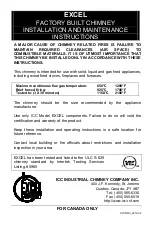
15
NOTE: DIAGRAMS & ILLUSTRATIONS ARE NOT TO SCALE.
Installation
900301-00 08/2018
Innovative Hearth Products
BRT40ST See-Through B-Vent Gas Fireplaces
Figure 15 -
GAS CONNECTION
Make gas line connections. All codes require a
shut-off valve mounted in the supply line.
Figure
15
illustrates two methods for connecting the
gas supply. The flex-line method is acceptable
in the U.S., however, Canadian requirements
vary depending on locality. Installation must
be in compliance with local codes.
A sediment trap is recommended in the gas
piping within the home to prevent moisture
and debris in the line from damaging the valve.
These appliances are equipped with a gas flex
line for use (where permitted) in connecting the
unit to the gas line. A gas flex line is provided to
aid in attaching the appliance to the gas supply.
The gas flex line can only be used where local
codes permit.
The flex line is rated for both natural and propane
gas. A manual shut off valve is also provided with
the flex line. The gas control valve is located in
the lower control compartment.
To access the valve open the lower control
compartment door (
see Figure 17
) by pushing
in the right top corner of the door. (The door
is hinged at the bottom). Remove the bottom
compartment door by sliding the hinge pin,
located at the door’s left side, to the right until
it disengages from the left corner post hole.
Pull the door diagonally to the left, away from
the fireplace.
The lower control compartment door on the
side opposite the valve lifts on and off.
The millivolt control valve has a 3/8"
(10 mm) NPT thread inlet port.
Secure all joints tightly using appropriate
tools and sealing compounds (ensure propane
resistant compounds are used in propane
applications).
All codes require a shut-off valve mounted in
the supply line. The orientation of the shut-off
valve should face the front.
Figure 15
illustrates
two methods for connecting the gas supply.
A sediment Trap is recommended to prevent
moisture and debris in the gas line for damag-
ing the valve.
NOTE:
Using a soapy water solution is an
effective leak test solution but it is not recom-
mended, because the soap residue that is left
on the pipes/fittings can result in corrosion
over time.
WARNING
Never use an open flame to
check for leaks.
TEST ALL CONNECTIONS FOR GAS LEAKS
(FACTORY AND FIELD):
STEP 5. CONNECTING GAS LINE
Turn on gas supply and test for gas leaks, us-
ing a gas leak test solution (also referred to as
bubble leak solution).
A.
Light the appliance (refer to the lighting
instructions label in the control compart-
ment or in the Installation and Operation
Instructions manual).
B.
Brush all joints and connections with the gas
leak test solution to check for leaks. If bubbles
are formed, or gas odor is detected, turn the
gas control knob (off/pilot/on) to the “OFF”
position. Either tighten or refasten the leaking
connection, then retest as described above.
C.
When the gas lines are tested and leak free,
be sure to rinse off the leak testing solution.
















































